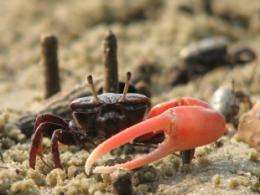Older male fiddler crabs are more likely to wave at females, and spend more time waving, than younger males, according to new research published today in Biology Letters.
Theory suggests that reproductive effort increases with age, and older males are often expected to perform more intense courtship displays. However, researchers at Australian National University have found that this is not always the case, and males can increase reproductive effort by other means.
Catherine Hayes and her team found that in fiddler crabs, Uca annulipes, intensity of the courtship waving display was the same for younger and older males. This is likely because females prefer faster waving, so younger males would gain little by waving below maximum intensity. Older males were instead able to increase their reproductive effort through being more likely to wave at females, and spending more time waving, than younger males.
The authors explain that one 'proximate' explanation for the finding is that older/larger males might more strongly stimulate neighbours to wave, which then stimulates the focal male to wave more himself. It is also possible that larger males might have greater visual clarity, which would increase their ability to detect and assess females and respond accordingly.
The researchers controlled experimentally for female presence and looked at male responses to mating opportunities. Male displays often depend on female presence. The team concluded that only by distinguishing between the likelihood of courtship initiation, courtship rate and persistence of courtship, are they now able to provide a fuller picture of male investment decisions.
More information: Hayes, C. et al., Does male reproductive effort increase with age? Courtship in fiddler crabs. Biology Letters. dx.doi.org/10.1098/rsbl.2012.1078
Journal information: Biology Letters
Source: The Royal Society




















